16 OCTOBER 2013 (+ AGM at 10.30am) (3rd Wed) From Russia: Diaghilev & the Ballets Russes 1909-1929
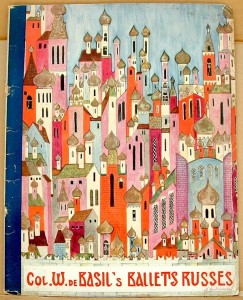 Russian and 20th century art is introduced through the work of Diaghilev, the Ballets Russes, and the costumes and set designs by leading artists such as Baskt, Benois, Goncharova, Larionov, Matisse and Picasso. Seminal productions covered will include ‘Scheherazade’ (1910), ‘The Golden Cockerel’ (1914) ‘The Firebird’ (1910), ‘Parade’ (1917), and ‘The Rite of Spring’ (1913) whose revolutionary music by Stravinsky and violent and erotic version of a pagan Russia shocked Western audiences.
Russian and 20th century art is introduced through the work of Diaghilev, the Ballets Russes, and the costumes and set designs by leading artists such as Baskt, Benois, Goncharova, Larionov, Matisse and Picasso. Seminal productions covered will include ‘Scheherazade’ (1910), ‘The Golden Cockerel’ (1914) ‘The Firebird’ (1910), ‘Parade’ (1917), and ‘The Rite of Spring’ (1913) whose revolutionary music by Stravinsky and violent and erotic version of a pagan Russia shocked Western audiences.
 Lecturer: Theodora Clarke An art historian, critic and lecturer specialising in Russian art and European modernism. Studied at the Courtauld Institute and Newcastle University. She lectures widely on 20th century avant garde painting and sculpture, including at the V&A, Tate Britain, the Courtauld Institute, the University of Bristol and Cambridge University. Also edits the online magazine ‘Russian Art and Culture’ and founded ‘Russian Art Week’ in London.
Lecturer: Theodora Clarke An art historian, critic and lecturer specialising in Russian art and European modernism. Studied at the Courtauld Institute and Newcastle University. She lectures widely on 20th century avant garde painting and sculpture, including at the V&A, Tate Britain, the Courtauld Institute, the University of Bristol and Cambridge University. Also edits the online magazine ‘Russian Art and Culture’ and founded ‘Russian Art Week’ in London.
13 NOVEMBER 2013 (2nd Wed) The Conservation and Restoration of Paintings
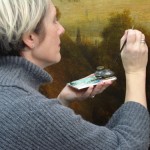 This lecture covers the ageing, deterioration and damage to paintings from the Middle Ages to the present day. Modern ‘museum standard’ approaches to conservation and restoration will be illustrated, with detailed slides ranging from early Italian religious paintings in egg tempera via rapid oil sketches on paper by Constable to 20th century British paintings and modern abstract works. Hints and advice on the general care of paintings are given.
This lecture covers the ageing, deterioration and damage to paintings from the Middle Ages to the present day. Modern ‘museum standard’ approaches to conservation and restoration will be illustrated, with detailed slides ranging from early Italian religious paintings in egg tempera via rapid oil sketches on paper by Constable to 20th century British paintings and modern abstract works. Hints and advice on the general care of paintings are given.
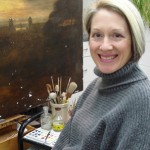 Lecturer: Sarah Cove An accredited Easel Paintings Conservator and specialist in historic painting techniques, especially British 16th-17th and 19th-20th century. Joint author of the Tate Britain exhibition catalogues ‘Constable’ (1991) and ‘Constable’s Six-Footers’ (2006). BA (Hons) History of Art (Courtauld); Internships V&A/National Portrait Gallery. Visiting Fellow at Yale 1989. Fellow of the British Association of Paintings Conservator-Restorers and International Institute for the Conservation and Preservation of Historic and Artistic Works.
Lecturer: Sarah Cove An accredited Easel Paintings Conservator and specialist in historic painting techniques, especially British 16th-17th and 19th-20th century. Joint author of the Tate Britain exhibition catalogues ‘Constable’ (1991) and ‘Constable’s Six-Footers’ (2006). BA (Hons) History of Art (Courtauld); Internships V&A/National Portrait Gallery. Visiting Fellow at Yale 1989. Fellow of the British Association of Paintings Conservator-Restorers and International Institute for the Conservation and Preservation of Historic and Artistic Works.
18 DECEMBER 2013 (3rd Wed) Beyond the Canon: The Artists of Cumbria
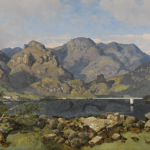 This beautiful part of England has attracted artists for almost three centuries. Apart from a wealth of landscape painting, numerous examples of high quality portraits, marine paintings, animal portraits, abstract painting and sculpture have all arisen in the region. Such artists as George Romney and Winifred Nicholson were locally born, while others, like J.M.W. Turner and Gainsborough, visited or, like Beatrix Potter and Kurt Schwitters, became new residents. This wide ranging lecture draws upon material in collections in the North West and worldwide.
This beautiful part of England has attracted artists for almost three centuries. Apart from a wealth of landscape painting, numerous examples of high quality portraits, marine paintings, animal portraits, abstract painting and sculpture have all arisen in the region. Such artists as George Romney and Winifred Nicholson were locally born, while others, like J.M.W. Turner and Gainsborough, visited or, like Beatrix Potter and Kurt Schwitters, became new residents. This wide ranging lecture draws upon material in collections in the North West and worldwide.
 Lecturer: David Cross Hon. Research Fellow, Durham University. Founder of the Cumbrian Biographical Project. Past President of Cumbria DFAS. Author of biography of George Romney. Specialises in Lake District artists of all genres. Art history lecturer to undergraduate and adult classes at Universities. Catalogue of Paintings in Durham Castle (2002). Researching Public Sculpture and Monuments in Cumbria.
Lecturer: David Cross Hon. Research Fellow, Durham University. Founder of the Cumbrian Biographical Project. Past President of Cumbria DFAS. Author of biography of George Romney. Specialises in Lake District artists of all genres. Art history lecturer to undergraduate and adult classes at Universities. Catalogue of Paintings in Durham Castle (2002). Researching Public Sculpture and Monuments in Cumbria.
8 JANUARY 2014 (2nd Wed) The Tiger in Asian Art
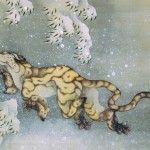 Intriguing and beautiful, tigers are some of the most awe-inspiring and mysterious creatures on earth. Feared and revered in equal measures, they have inspired countless legends, beliefs and works of art. This lecture explores the significance of the tiger as a symbol of power and protection in its Asian homeland, illustrated by a diverse range of art and artefacts. The tiger is seen in early Chinese bronzes, Japanese netsukes, Indian paintings, Tibetan rugs and other Asian works of art.
Intriguing and beautiful, tigers are some of the most awe-inspiring and mysterious creatures on earth. Feared and revered in equal measures, they have inspired countless legends, beliefs and works of art. This lecture explores the significance of the tiger as a symbol of power and protection in its Asian homeland, illustrated by a diverse range of art and artefacts. The tiger is seen in early Chinese bronzes, Japanese netsukes, Indian paintings, Tibetan rugs and other Asian works of art.
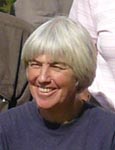 Lecturer: Zara Fleming Freelance lecturer and art consultant specialising in the art and culture of Tibet, the Himalayan areas and Mongolia. Initially based at the V&A, but also worked at Bonn University, the Orient Foundation, the Royal Academy, Tibet House, the National Museums and Galleries on Merseyside and Asia House. She is also guest lecturer and tour guide on numerous trips to the Himalayas. Edited ‘Masterpieces of Mongolian Art: Vol 1’ and has published many articles in the field of Buddhist art and culture.
Lecturer: Zara Fleming Freelance lecturer and art consultant specialising in the art and culture of Tibet, the Himalayan areas and Mongolia. Initially based at the V&A, but also worked at Bonn University, the Orient Foundation, the Royal Academy, Tibet House, the National Museums and Galleries on Merseyside and Asia House. She is also guest lecturer and tour guide on numerous trips to the Himalayas. Edited ‘Masterpieces of Mongolian Art: Vol 1’ and has published many articles in the field of Buddhist art and culture.
12 FEBRUARY 2014 (2nd Wed) From Riches to Rags: The Huguenot Silk Weavers of Spitalfields
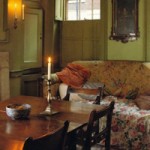 Welcomed at first with open arms and bringing luxury skills, the Huguenots’ fortunes fluctuated wildly. The talk covers their early 18th-century houses that still stand, how they were decorated and lived in; who designed and made their fashionable patterned silk dresses; and how, finally the trade died out, with some weavers literally dying in poverty at their looms. One of the weavers’ houses can still be visited today.
Welcomed at first with open arms and bringing luxury skills, the Huguenots’ fortunes fluctuated wildly. The talk covers their early 18th-century houses that still stand, how they were decorated and lived in; who designed and made their fashionable patterned silk dresses; and how, finally the trade died out, with some weavers literally dying in poverty at their looms. One of the weavers’ houses can still be visited today.
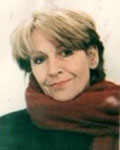 Lecturer: Sue Jackson Originally in art and design publishing (Phaidon and Yale University Press), now lectures for the National Trust, U3A, City Literary Institute. A qualified Blue Badge Guide, she gives guided walks on various themes and has published work on the lost world of the River Fleet.
Lecturer: Sue Jackson Originally in art and design publishing (Phaidon and Yale University Press), now lectures for the National Trust, U3A, City Literary Institute. A qualified Blue Badge Guide, she gives guided walks on various themes and has published work on the lost world of the River Fleet.
12 MARCH 2014 (2nd Wed) Lost on the Titanic: The Making of the Great Omar Binding
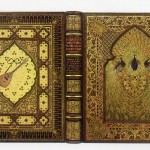 This was the most fabulous, elaborate and opulent binding ever created. It was embellished with over one thousand jewels, five thousand leather onlays and a hundred square feet of gold leaf, and took a team of craftsmen over two and a half years to make. It went down with the Titanic. This lecture tells the story of its making and the moving story of life after the tragedy when one young man decided, against the odds, to recreate the binding.
This was the most fabulous, elaborate and opulent binding ever created. It was embellished with over one thousand jewels, five thousand leather onlays and a hundred square feet of gold leaf, and took a team of craftsmen over two and a half years to make. It went down with the Titanic. This lecture tells the story of its making and the moving story of life after the tragedy when one young man decided, against the odds, to recreate the binding.
 Lecturer: Dominic Riley Studied Art History at the University of Leeds and Bookbinding at the London College of Printing. A professional bookbinder, he has lectured to colleges, art centres and antiquarian book fairs in both the UK and USA and has curated bookbinding exhibitions in San Francisco. Has published in The Ampersand, The Bookbinder and The New Bookbinder and was editor of Gold Leaf, the journal of the Hand Bookbinders of California.
Lecturer: Dominic Riley Studied Art History at the University of Leeds and Bookbinding at the London College of Printing. A professional bookbinder, he has lectured to colleges, art centres and antiquarian book fairs in both the UK and USA and has curated bookbinding exhibitions in San Francisco. Has published in The Ampersand, The Bookbinder and The New Bookbinder and was editor of Gold Leaf, the journal of the Hand Bookbinders of California.
9 APRIL 2014 (2nd Wed) Edwin Lutyens’ work abroad
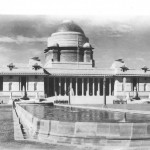 While Lutyens’ work in Britain is well known, especially his country houses, his work abroad is not. This ranged from a private house in France, a stunning series of War Memorials, the British School at Rome, and of course to the creation of buildings for the capital of India at New Delhi. This lecture examines these works and looks at how the commissions came about, how each project was managed, and how they relate to the local historical context.
While Lutyens’ work in Britain is well known, especially his country houses, his work abroad is not. This ranged from a private house in France, a stunning series of War Memorials, the British School at Rome, and of course to the creation of buildings for the capital of India at New Delhi. This lecture examines these works and looks at how the commissions came about, how each project was managed, and how they relate to the local historical context.
Lecturer: Andrew Hopkins
21 MAY 2014 (3rd Wed) Tribal Rugs: Treasures of the Black Tent – A Journey through the Weaving History of the Nomadic Tribes of the Near East, Persia and Central Asia
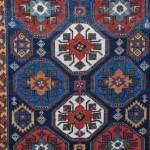 The lecturer draws on his experience of living amongst the nomads of Iran and his travels throughout the Near East and Afghanistan. The journey begins in Outer Mongolia in the 5th century BC and follows the 11th century migrations from Central Asia, the cradle of weaving, into the Caucasus, Anatolia, Persia and Afghanistan. These tribal weavings of woven rugs, carpets and dowry bags illustrate the skill of the women using vegetable colours and age-old designs, including cosmic and talismanic symbols, whilst living and travelling in primitive conditions and hostile landscapes.
The lecturer draws on his experience of living amongst the nomads of Iran and his travels throughout the Near East and Afghanistan. The journey begins in Outer Mongolia in the 5th century BC and follows the 11th century migrations from Central Asia, the cradle of weaving, into the Caucasus, Anatolia, Persia and Afghanistan. These tribal weavings of woven rugs, carpets and dowry bags illustrate the skill of the women using vegetable colours and age-old designs, including cosmic and talismanic symbols, whilst living and travelling in primitive conditions and hostile landscapes.
 Lecturer: Brian Macdonald Dealer and consultant in antique oriental rugs and carpets since 1979. Author of ‘Tribal Rugs’ (1997) re-printed 2010. He is one of few western dealers to have lived and worked among tribal groups in remote areas of Iran and Afghanistan during the 1970s and then again, after the Iranian Revolution, in the 1990s. In 1990 he was elected a Fellow of the Royal Geographical Society for his work amongst the Persian tribes.
Lecturer: Brian Macdonald Dealer and consultant in antique oriental rugs and carpets since 1979. Author of ‘Tribal Rugs’ (1997) re-printed 2010. He is one of few western dealers to have lived and worked among tribal groups in remote areas of Iran and Afghanistan during the 1970s and then again, after the Iranian Revolution, in the 1990s. In 1990 he was elected a Fellow of the Royal Geographical Society for his work amongst the Persian tribes.
11 JUNE 2014 (2nd Wed) Pipers and Tune: John and Myfanwy Piper and the Music of Benjamin Britten
Piper’s stage designs and his wife’s librettos were integral to the development of Britten’s operas. The friendship between Piper and Britten began, developed and strengthened through their working together, and their passion for the unity of the Arts in the theatre. What sounded good must look good, what made musical sense must make visual and poetic sense as well. Piper made a sustained contribution to Britten’s operas, strengthened by the role of his wife as librettist of three operas: ‘The Turn of the Screw’, ‘Owen Wingrave’ and ‘Death in Venice’ .
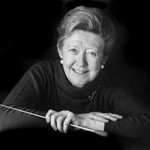 Lecturer: Janet Cannetty-Clark Trained at the Royal Academy of Music. Lecturer in Music for the Centre for Community Engagement at Sussex University; individual lectures Madingley Hall (Cambridge), Birkbeck (London), U3A and the WEA. Conductor Emeritus of The Sussex Chorus for 37 years and guest conductor of Frauen-Kammerorchester von Österreich in Vienna for 16 years. She recently completed 37 years as Conductor and Musical Director of the Ditchling Choral Society.
Lecturer: Janet Cannetty-Clark Trained at the Royal Academy of Music. Lecturer in Music for the Centre for Community Engagement at Sussex University; individual lectures Madingley Hall (Cambridge), Birkbeck (London), U3A and the WEA. Conductor Emeritus of The Sussex Chorus for 37 years and guest conductor of Frauen-Kammerorchester von Österreich in Vienna for 16 years. She recently completed 37 years as Conductor and Musical Director of the Ditchling Choral Society.
